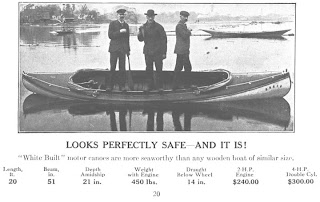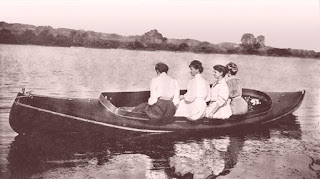As a canoe builder and restorer I am often asked: Which is
your favourite canoe? Well, it’s not one, I have
many favorites; paddling canoes, motor canoes, sailing canoes, some are canoes with interesting stories and some are favourites because of their construction, design and style. Here is one favorite, the Chestnut motor canoe, a
rare one. I will occasionally present a few others that I think are worthy of special mentioning.
 |
| Chestnut Canoe Co ad. |
In the early 1900’s the internal combustion engine changed
most aspects of life and commerce, on land and water. The most common small
engine of the day was the single-cylinder, two-cycle engine often called
“one-lunger” or “make-and-break”. One-lunger referred to the single cylinder
and make-and-break referred to the ignition system. This little motor was used
as marine engines, stationary engines powering farm equipment, sawmills, and
washing machines, and much more. It was the choice motor for fishermen and
pleasure boaters alike for the next two decades beginning around 1900.
Motorized boats found an eager audience in a growing population with time and money
to spend.
 |
| E. M. White motor canoe ad. |
One of the first of the North American canoe builders to
recognize this new market was the E.M. White & Co in Maine. Already in 1902
they had a stock model motor canoe for sale to the public looking for a new and
modern way to get out on the water.
In 1905 the Chestnut Canoe Co was a small regional canoe
maker, with its first catalogue just out, offering only three models. It is
clear that the company a couple of years later was doing a very good business
right across Canada with a large line-up of canoe models to choose from.
Clearly, the Chestnut Canoe Co wasn’t shy about “borrowing” ideas and quickly had
picked up on the idea of a motorized canoe. Their motor canoe, first offered in
1907, was an almost exact copy of the E. M. White & Company’s motor canoe
with “invisible sponsons”.
The Chestnut Canoe Co introduced their 20 ft. freight
canoe in 1907 and its hull was also used for the inboard motor canoe. Ten
motor canoes were produced that first year.
The cross section above shows the peculiar shape of the hull
and the built in invisible air chambers which were added onto the full length
of a canvassed hull and extending below the waterline. The hull was then again
canvassed, filled and painted, making the air-chambers completely sealed. These
chambers make the craft so steady that it is practically impossible to upset it
and they make the canoe so buoyant that it will support more people than can be
crowded into it.
 |
| Chestnut foursome. |
The Chestnut inboard
motor canoes were made in two lengths; 18-ft. and 20-ft. A range of options and
equipment were available such as; Harlow awnings, special chairs and seats,
spray hoods etc.
The canoes came equipped with the customer’s choice of three
versions of an engine made by the St. Lawrence Engine Co in Brockville,
Ontario. Their basic single cylinder engine model was produced almost unchanged
for sixty years. Each engine was hand built one at the time.
By 1920 the inboard
motor canoe models had disappeared from the Chestnut offerings and had been
replaced with the new fad; the square stern canoe equipped with the outboard
motor.
A Chestnut motor canoe with the invisible sponsons is quite
rare, I know of only a handful, one of them in the collection at the Canadian
Canoe Museum. Their canoe, or what is left of it, is unfortunately in poor
condition and is missing all hardware, motor, propeller, tank and piping, bow
& side steering wheels, rub rails, oak coaming, keel, seats, chairs and its
canvas covering. Two feet of the stern have been cut off and replaced by a
transom.
If any of you have a Chestnut motor canoe for sale, I am
interested.















No comments:
Post a Comment